
Overview of Indian
Eating Culture
English Translation: Aki Yahata
Eating with hand is the basis of the Indian way of eating, and it is impossible to talk about Indian food without eating with hand. However, there is no single unified method of eating with hand in India, which is so vast geographically and culturally. Therefore, if we want to look at it in detail, we have to look at it individually, giving examples from each region, each store, and each individual’s home, as appropriate.

The contraindications for the right or left hand
As is well known, in India, the right hand is considered purity/clean and the left hand is considered unclean/impurity. Therefore, eating is basically done with the right hand. At first glance, this concept of purity and impurity is likely to be seen that it is unique to Hinduism, also it is easy to assume that the presence or absence of left and right hand prohibitions is tied to the Hindu way of thinking.
However, people of non-Hindu religions in India (Muslims, Christians, etc.) also often eat with their right hand only. This concept of using right hand mainly is not limited to India, but is found widely throughout Asia and the Middle East, and is thought to have been shared even before the emergence of specific religions.
The manner of eating with the right hand tends to be more pronounced in the higher social classes. Nevertheless, the notion of purity or impurity of the left and right hands is not as much of a concern when cooking as it is when eating with one’s hands. It is impossible to cook rice or knead flour with only one right hand, whether in North or South India. The same is true even in Hindu temples, where the concept of purity and impurity is strictly observed. If the left hand is impure, it should not be used in the cooking process, but the fact that this is not the case suggests that the prohibition of the left and right hands is not based on the concept of purity or impurity in nature.
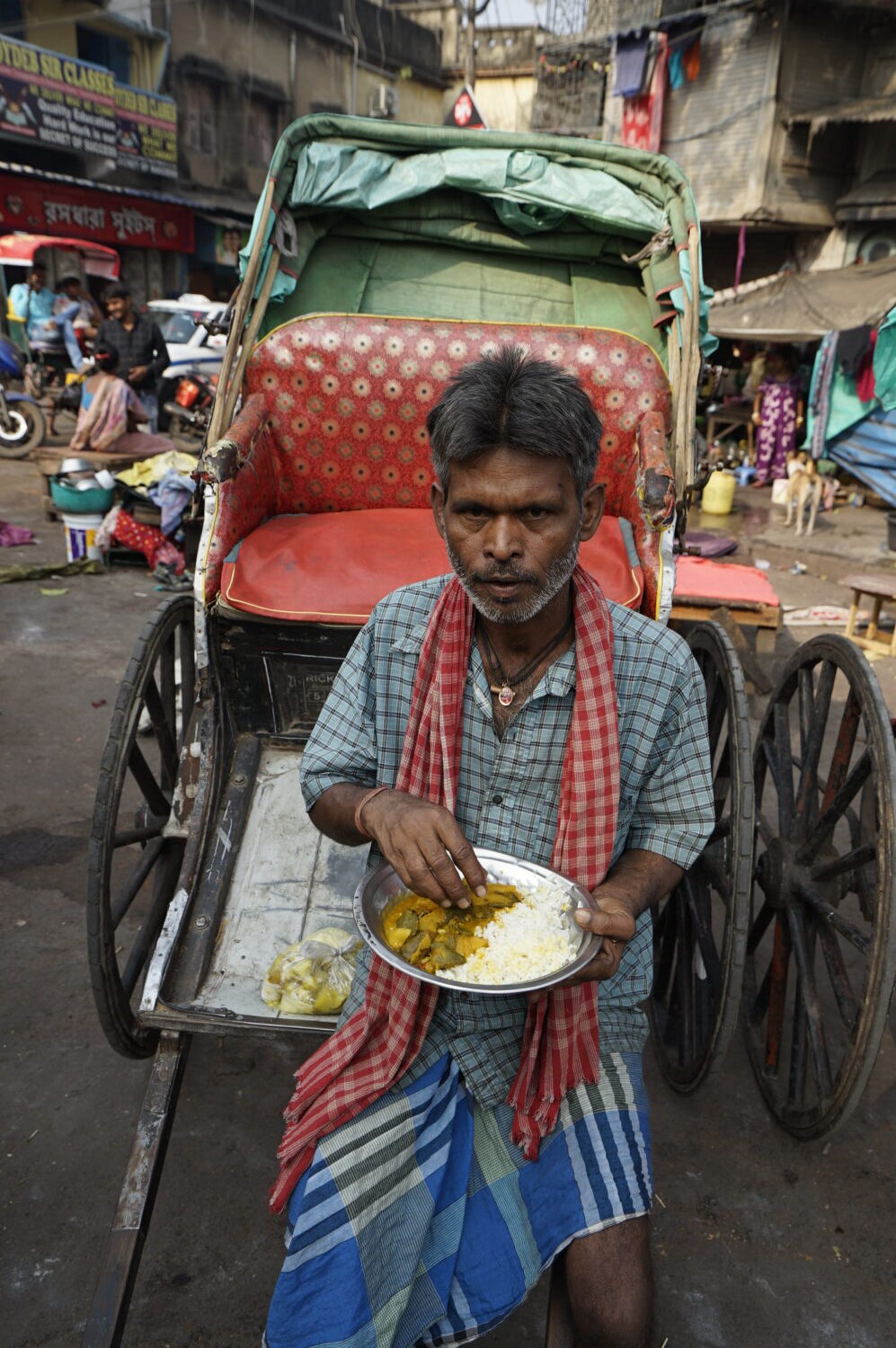
Eating style based on the belief in the Earth Mother Goddess
A table is a board for eating or working, and it is a daily life tool/furniture brought to India by Islamic powers and Western countries. In India, where the belief in the Earth Mother Goddess is originally strong, the style of eating by placing the plate directly on the sacred earth has continued. This is also connected to the behavioral pattern of not defiling the earth with one’s feet (= being barefoot).
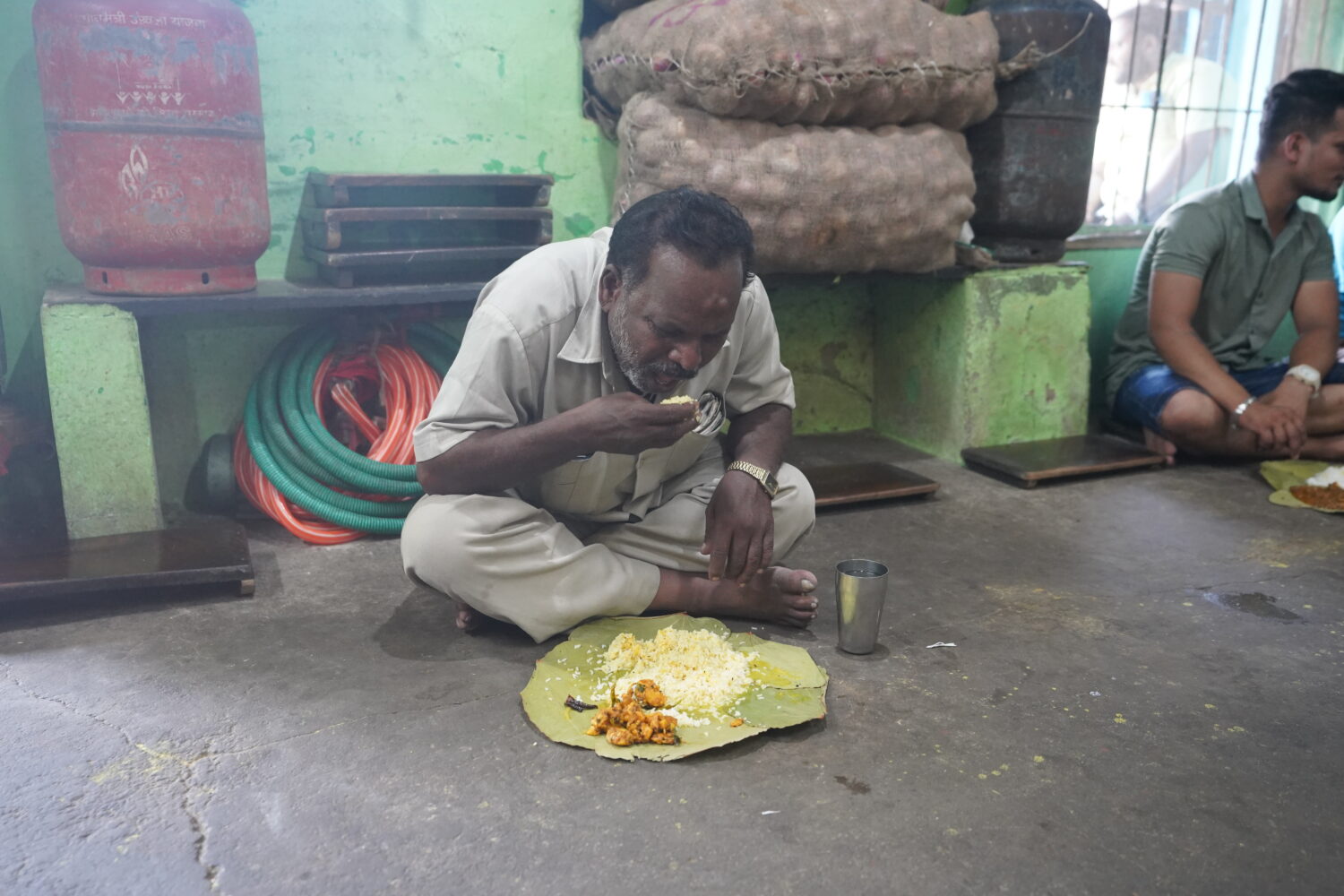
Customers sit directly on the floor and are served food on leafy plates.
Although India is now crowded with mass eateries, family restaurants, and hotels, it is still common to see people eating meals by placing plates directly on the ground or floor of temples throughout the country. Hindus have a custom of eating meals left over by the gods (prasad), but in this case (with a few exceptions, such as temples and pilgrimage sites in Rajasthan), tables are not used.
On the other hand, due to the influence of westernization, families nowadays often eat meals on chairs at the dining table. Originally, the father, the head of the family, ate first, followed by his sons and other family members, and the mother or wife, who served the family, ate last. However, in some conservative areas, such as rural villages, eating on the floor is still the norm. When a Muslim family has a guest, a carpet is laid on the floor, and the guest and the male members of the family sit in a circle, with a platter of food placed in the center of the circle, and eat together. The same is true for weddings in Kashmir. (On the other hand, weddings in urban areas in northern India tends to often be held with a standing buffet nowadays.)
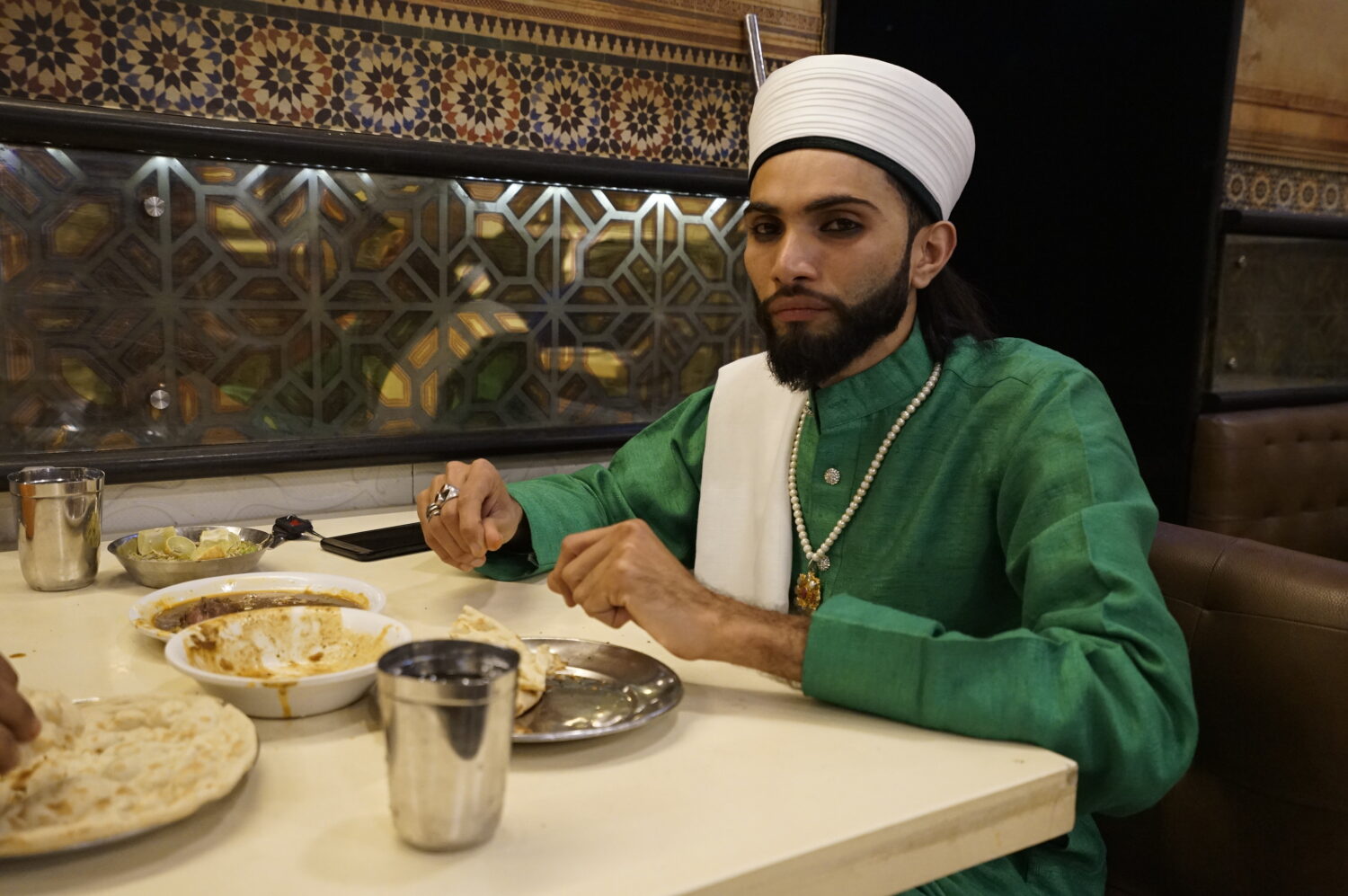

Pidha Hotel, located in Brahmapur, in the eastern Indian state of Odisha, is unusual for a restaurant where it serves food on leafy plates placed on the floor. Customers sit cross-legged on the pidha (small cushion-like chair), which is also the name of the restaurant, and wait for their food to be served on leafy plates. Apart from homes, temples, and other religious institutions, there are few places that serve meals on the floor for a fee.
In India in general, manners are not as meticulous as in Japan, and a certain amount of freedom is allowed in the way people sit. While eating, the most common posture for both men and women is sitting cross-legged, but there is nothing wrong with occasionally sitting on one knee.
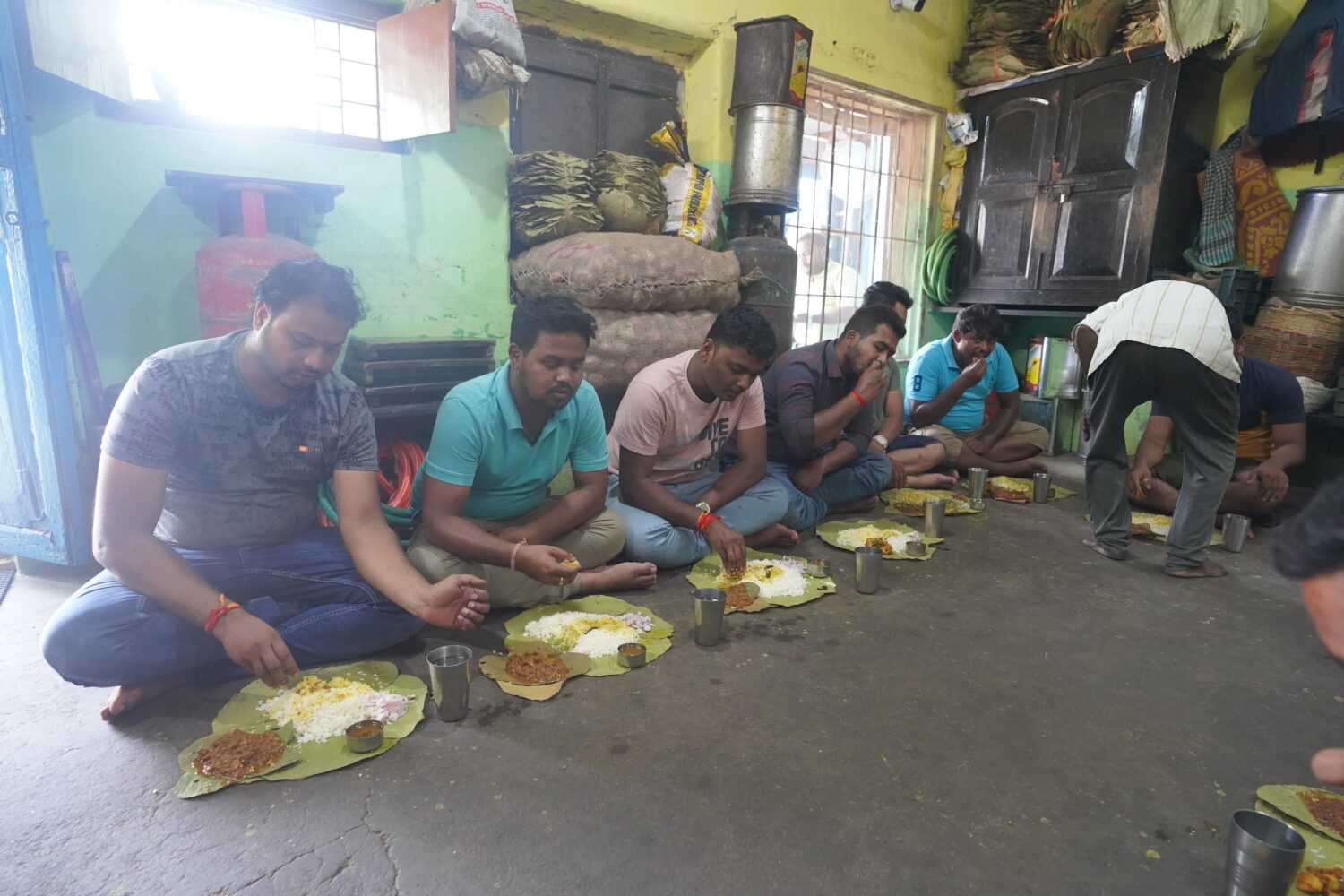
In India, kitchen work has traditionally been done sitting on the floor. In such a case, a large knife, especially for cutting fish, is fixed to the floor and the blade is placed against the food to be cut. In order to fix the knife in place, one knee may be raised to support the base of the knife with the toes.
As mentioned above, India does not have the same sense of aversion and impurity toward the floor and the ground as Japan does, and in fact, the opposite is true. Therefore, the more formal the occasion, such as a wedding ceremony or temple visit, the more likely people tend to place food on the floor.
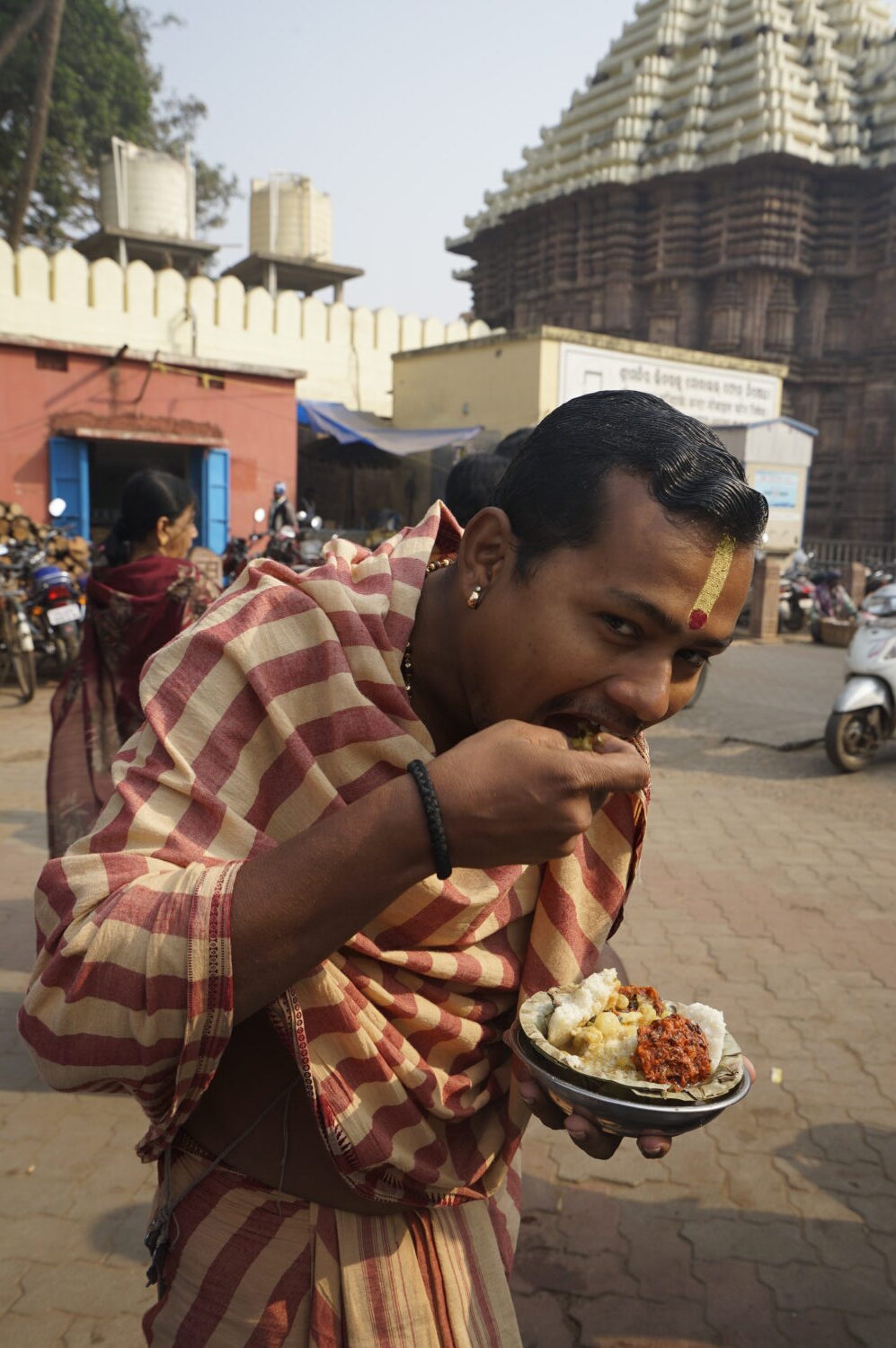
Plate setting
Most people take their food from a shared big platter onto an individual plate. However, during a Muslim wedding feast, several people gather around a platter of food and eat it together with their hand.
In Indian households, the cooked food is placed on the floor or table, and each person takes a portion from the pot onto his or her own thali plate. This is the original and typical scene of Indian meals. The cooked pots are called “Kadahi” or “Handi“, depending on their shape, and Indian restaurants today use similarly shaped pots as curry plates with a smaller size and decorated with copper or brass on the outside. These dishes, which also can still be seen in many Indian restaurants in Japan, originated from such cooking utensils used at home.

Eating with hand surrounding a pot with food.
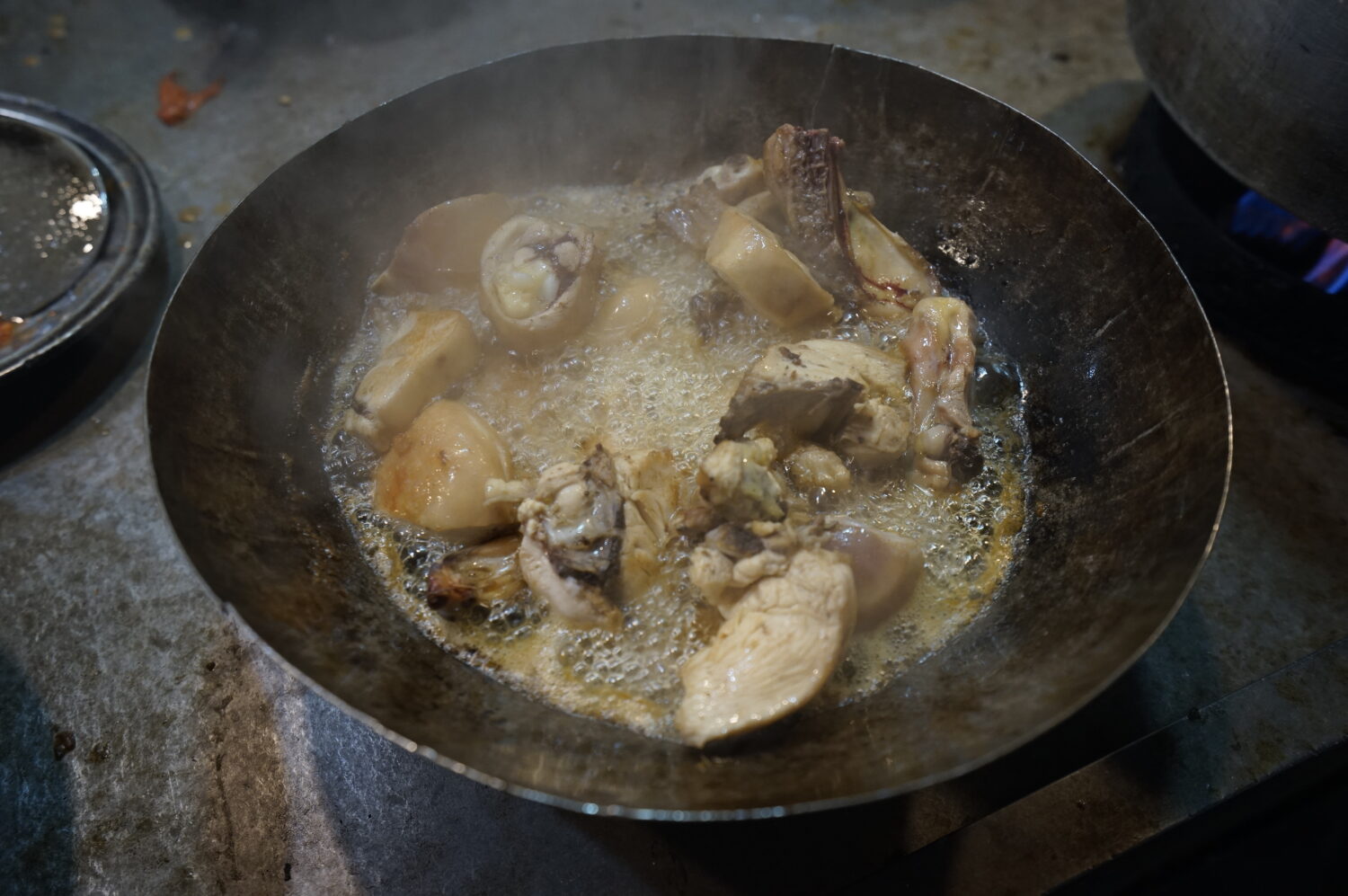
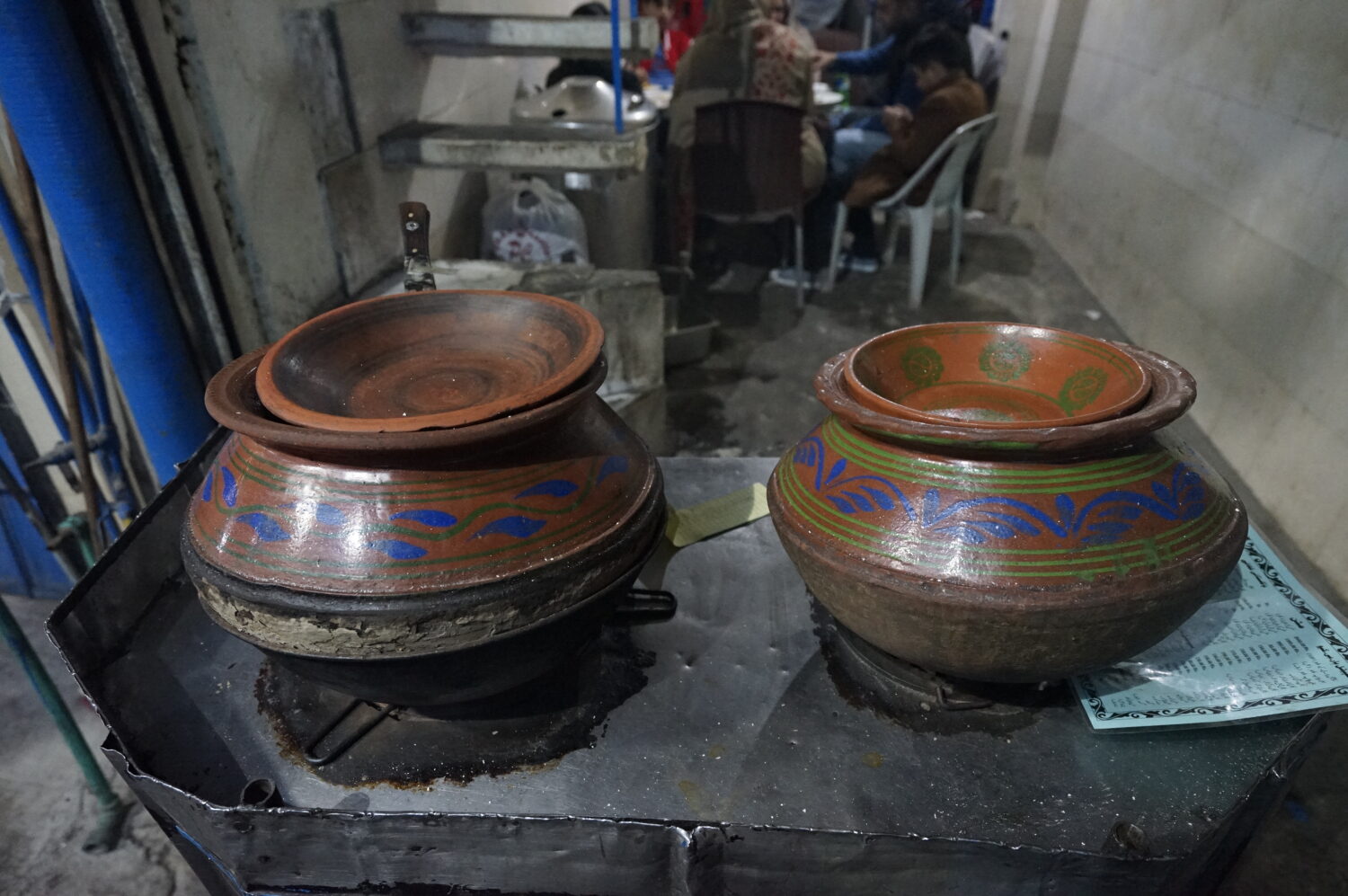
When placing food from the cooking pot onto the respective thali, an Indian-style ladle, such as a “Karchi“, is used.

Methods and Significance of Eating with Hand
Everything on the thali is eaten with the hand. Basically, as soon as rice is placed on the thali, it is gently stirred with the right hand, as if it were a foreplay to the meal. However, this is an important process, because cheap white rice in India sometimes contains small pebbles of the same color. The action, in which the rice seems to be stirred with the right hand more than necessary, is including this sorting process to remove pebbles.
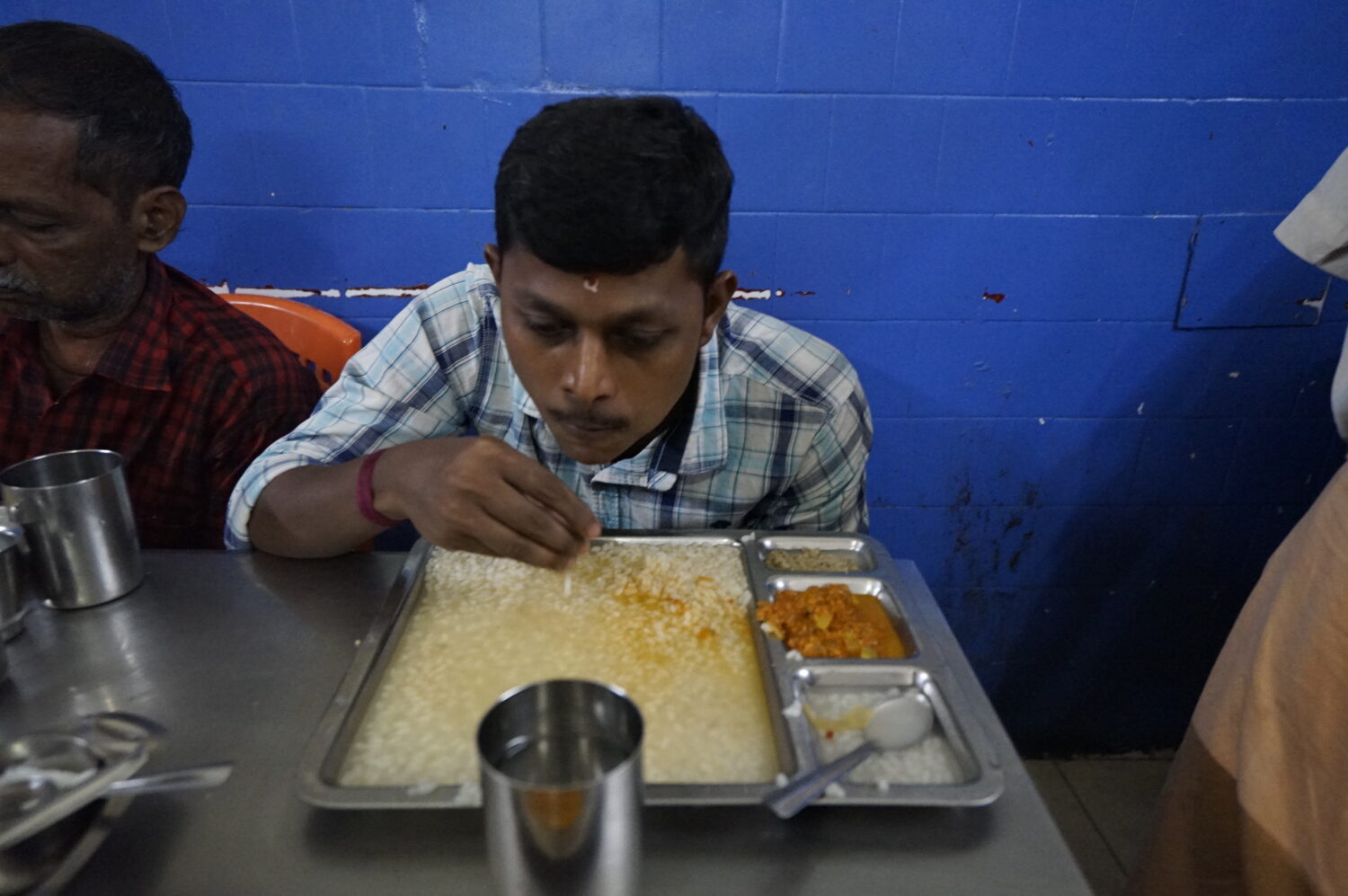
Eating kanji (watery porridge) with hand is quite difficult because of the soupy nature of the food.
Since Indians believe that the taste that comes from the bones of animals and fish, and the joint between the bones and the meat, is the most delicious part of the dish, basically meat with bones is used for Indian dishes. Many dishes are similar in shape to the curry that Japanese people imagine, but if you try to eat them with a knife and fork or chopsticks, you will face difficulty. It is almost impossible to eat the small pieces of meat that remain behind the bones unless you hold the meat with your hands. Japanese eat fish with chopsticks with great dexterity, while Indians, especially Bengalis who are famous for their love of fish, deftly remove fish meat from the bones using only their right fingers.

Eating rice and side dishes served on banana leaves with hand.
The Future of Indian Eating with Hand
India is now the world’s fifth largest economy. India’s economy is making great strides, and it is said that it will overtake Japan, currently the fourth largest economy, in a few years. One of the sources of its economic strength is the IT industry.
Although there are disparities, the benefits generated by this economic effect are steadily raising the standard of living of the Indian people as a whole. One symbol of this is the smartphone. Even low-income earners now have one smartphone per person. The other day, when I was riding in a cab on the streets of Mumbai, I looked out the window and was surprised. I found homeless people fiddle with their smartphones with great enthusiasm. Where in the world do they charge their phones when they don’t even have a home? More importantly, can street dwellers, whose literacy rate is generally said to be low, read and write on their smartphones? I was quite confused.
In India today, the app delivery service is more advanced than in Japan, and all the food delivered is paid for with a smartphone. A decade ago, people could be seen leisurely enjoying their breakfast with chai and biscuits at a chai shop with a newspaper, but nowadays this has been replaced by playing smartphones. However, the proliferation of the app delivery services does not mean that even the food delivered has changed.
In North India, for example, biryani, curries and rotis (bread) are delivered in small bags, and in South India, meals are wrapped in banana leaves. The meal is then opened and eaten by hand. Of course, while eating, one is watching a cricket match or a Bollywood movie on one’s smart phone “while eating with hand” in an unbecoming manner, but no matter how many peripheral devices and apps become available, the eating-with-hand itself remains constant. Indians use only their right hand for eating-with-hand. The left hand, which is unclean/impurity, is not allowed to be used for eating. If this is the case, you can use your free left hand to operate your smartphone as much as you like. In this sense, it could be said that the smartphone is a gadget suitable for eating with hand.
For Indians, their hand or the pad of their fingers seem to be an extension of their tongues. Therefore, when it comes to eating with a spoon or other utensil, the act of eating is completed without a certain sense of touch. This is an incomplete act for Indian hand-eaters. Their reliance on hands tends to be seen it is associated with religious beliefs, but on the other hand, many Indians are rational thinkers, and shortcuts in daily life using smartphones are now very common. The idea of using unclean hands for fiddling with smartphones is part of their rationale.
The introduction of smart phones and IT devices, which are the art of civilization, does not mean that the “physicality” of seeing things with the naked eye and hearing sounds with the ears will be lost. In this sense, no matter how much the times change and how convenient the world becomes in the future, Indian eating-with-hand will continue to exist because of its physicality, which will not be eroded by anything.
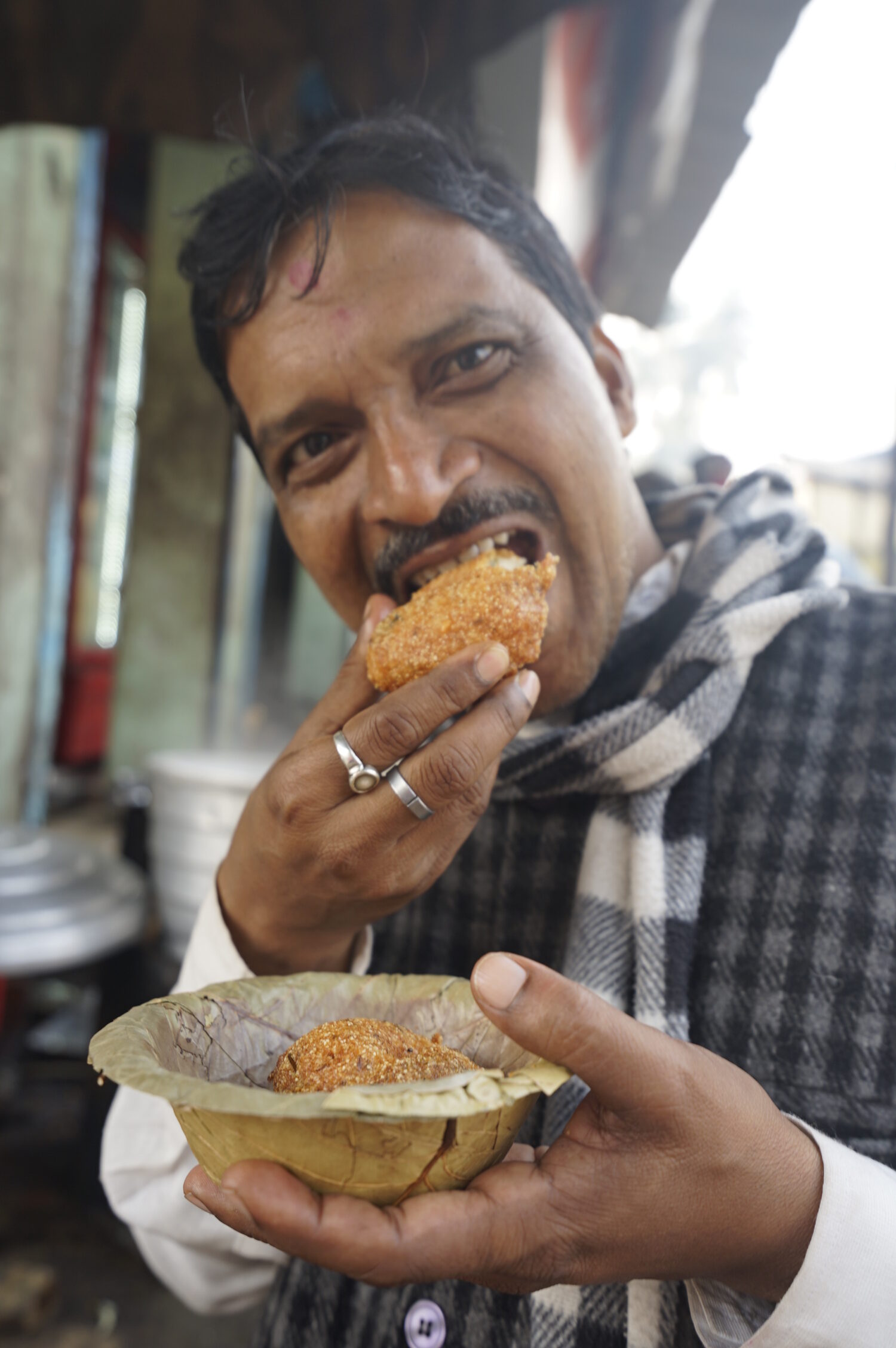
Eating with hand is norm for snacks.
Profile

Masaki Kobayashi
Representative of Asia Hunter Ltd., an importer and wholesaler of Indian tableware and cookware.
He began traveling to India around 1990 and has stayed there every year since then. His greatest interest is the food culture of the Indian subcontinent.
He is the author of "A Food Travelogue of the Indian Subcontinent in Japan," "Indian and Nepalese Restaurants in Japan," and "Food Crawl around India. "
His latest book is "India's Kitchen" (Sakuhinsha, scheduled for publication in late May 2024).





Leave a
Comment